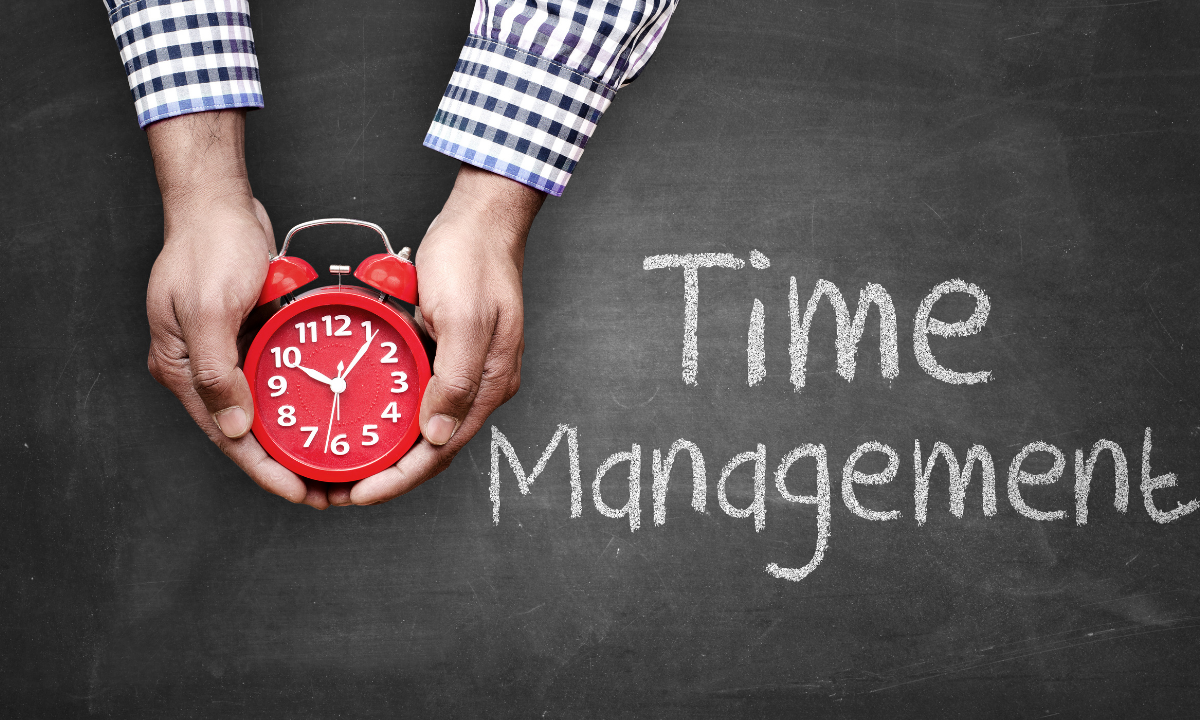
Time management brings to mind the timeless phrase, "Time is money". But how do time management techniques vary for you weekdays vs. weekends? That's the million-dollar question.
Related Course: Time Management Online Course Free
This engaging discussion dives into the subtle but distinct variations in how individuals manage their time during the workweek and the pleasant diversion that the weekends offer.
Why is this Interview Question Asked: How Do Time Management Techniques Vary for You Weekdays vs. Weekends?
Why would an interviewer possibly care about how much time you spend lounging on your couch on a Sunday, right? Surprisingly, the way you organize your time outside professional obligations provides valuable insights into your personal traits, work-life balance, priority setting, and stress-relief methods.
These aspects prove crucial in determining whether you fit the role and the company's culture. Additionally, with the ongoing remote work scenario, segregating professional and personal time has posed a challenge. Hence, organizations are keen on understanding your weekend time management principles.
The Purpose of the Question
The purpose behind, "How do time management techniques vary for you weekdays vs. weekends?" is to gauge how adaptable and versatile you are with your schedule. Weekdays often have a structured routine filled with tasks and deadlines, while weekends are commonly for relaxation, hobbies, or personal errands.
The balance you strike between these starkly contrasted days provides a glimpse into your capability to handle change, stress, and free time. This balance equips HR managers with the much-needed evaluation of your personal productivity process.
At What Interview Level is It Asked?
This question chiefly finds its place in mid or high-level job interviews when the recruiters are not just sizing up your tactical skills, but also tuning into your strategic approach towards life and work.
These roles often require juggling multiple tasks and dealing with unpredictable scenarios. Therefore, understanding your time management strategies is crucial for higher authority roles.
What Kind of Answer is Expected from the Candidate?
The hiring team expects an answer that goes beyond, “I relax or spend time with family”. They expect you to convey the strategic considerations behind your time management decisions.
It might be how you segment your weekend into productive mornings and relaxed evenings, or perhaps you utilize the weekends for catching up on industry trends or learning new skills.
The purpose is to showcase how you leverage your free time beneficially without sacrificing leisure or mental peace.
Possible answers to "How Do Time Management Techniques Vary for You Weekdays vs. Weekends?"
"During weekdays, my focus is entirely on work, managing projects, meeting deadlines, and collaborating with the team. However, weekends are for my personal development and relaxation. I devote Saturday mornings to learning new skills or attending industry webinars and the rest of the time to hobbies and family. This allows a balance between professional growth and personal leisure."
"For me, weekdays are pretty structured with a strict schedule, while weekends are flexible. Interestingly, I manage my Saturdays like a business day, dedicating it to freelance projects, and Sundays are for unwinding and planning for the upcoming week."
"While I operate on a structured schedule with set targets during weekdays, my weekends are more goal-oriented rather than time-oriented. I list out a few tasks that I wish to achieve but lean on a relaxed timeframe to do so. This not only keeps me productive but also ensures I get adequate relaxation."
What to Consider When Answering
When answering, “How do time management techniques vary for you weekdays vs. weekends?” consider the image you wish to portray. Your reply should communicate a balance between work, personal growth, and relaxation because each element is crucial in comprehensively assessing your personality type.
It’s not about impressing with busyness, but showcasing your ability to balance productivity and personal well-being. Remember, genuine and well-thought-out responses work wonders.
When the spotlight comes on time management variances for weekdays and weekends, it's the perfect opportunity to showcase your balanced approach towards work and life.
After all, the key to effective time management is not about packing in more tasks but ensuring the tasks undertaken are fruitful and rewarding. So, how do time management techniques vary for you weekdays vs. weekends? This might be your winning answer to secure your desired role.
Comparison of Task Prioritization During Weekdays vs Weekends
Distribution of Personal and Professional Activities: Weekday vs Weekend
Time Allocation for Work, Leisure, and Self-Care: A Weekday and Weekend Perspective
Similar interview questions:
Can you describe how your time management skills differ between weekdays and weekends?
What are the differences in the way you manage your time on weekdays as compared to weekends?
How does your approach to time management change from weekdays to weekends?
Can you give a comparison between your time management techniques on weekdays and weekends?
What variations exist in your application of time management methods between weekdays and weekends?
Are there any specific changes you make on your time management strategies when transitioning from weekdays to weekends?
Can you elaborate on the dissimilarities in your time management strategies during weekdays and weekends?
In what ways does your time management techniques vary during weekdays and weekends?
What does your comparison look like when discussing time management techniques for weekdays vs. weekends?
How do you differentiate your application of time management strategies to suit weekdays and weekends?

Frequently Asked Questions
How do you prioritize tasks on weekdays compared to weekends?
Weekdays: Focus on Key Priorities
During the work week, I prioritize my tasks based on importance and urgency. I start each morning by identifying the top 3-5 essential tasks I need to complete that day. These are usually high-impact projects, looming deadlines, or tasks that align with my most important goals.
Throughout the day, I tackle these key priorities first before moving on to less time-sensitive items. If unexpected issues come up, I assess where they fall in terms of importance. I'm not afraid to adjust my plan if something truly critical arises. But in general, I try to stay focused on knocking out those core tasks I identified at the start of the day.
Weekends: A Balance of Obligations and Recreation
On weekends, my priorities shift a bit. I still have responsibilities and tasks to attend to, but I also make time for rest, hobbies, and socializing. It's important to me to recharge so I'm refreshed for the coming work week.
I usually reserve part of the weekend, like a Saturday morning, to take care of personal tasks - things like paying bills, running errands, or light chores around the house. I'll also carve out a few hours for any work tasks that spilled over from the week.
But overall, I prioritize relaxation and fun on the weekends. Connecting with friends and family, getting outdoors, working on a hobby - these types of restorative activities are a priority for me on Saturdays and Sundays. I've found that when I protect my weekends, I'm more energized and productive when I return to work.

What strategies do you use to balance work and personal life?
I prioritize my tasks based on urgency and importance, ensuring that I meet deadlines while maintaining a healthy work-life balance. I set realistic goals for each day and week, focusing on the most critical tasks first. This helps me stay organized and avoid feeling overwhelmed by my workload.
Communicating with my team and family
Open communication is key to balancing work and personal life. I make sure to communicate my schedule and availability to my colleagues and family members. This helps manage expectations and prevents conflicts between work and personal commitments.
Flexibile work arrangements
I take advantage of flexible work arrangements when possible, such as working from home or adjusting my hours. This allows me to better manage my time and attend to personal matters without sacrificing work quality or productivity.
Setting boundaries and disconnecting
I set clear boundaries between work and personal time, avoiding work-related activities during off-hours whenever possible. Disconnecting from work emails and calls during personal time helps me recharge and focus on my family and hobbies.
Regular exercise and self-care
Engaging in physical activity and practicing self-care are essential for maintaining a healthy work-life balance. I make time for exercise, meditation, or hobbies that help reduce stress and improve my overall well-being.
Continuous evaluation and adjustment
I regularly assess my work-life balance and make adjustments as needed. If I find myself feeling overwhelmed or neglecting personal commitments, I take steps to realign my priorities and make necessary changes to my schedule or workload.
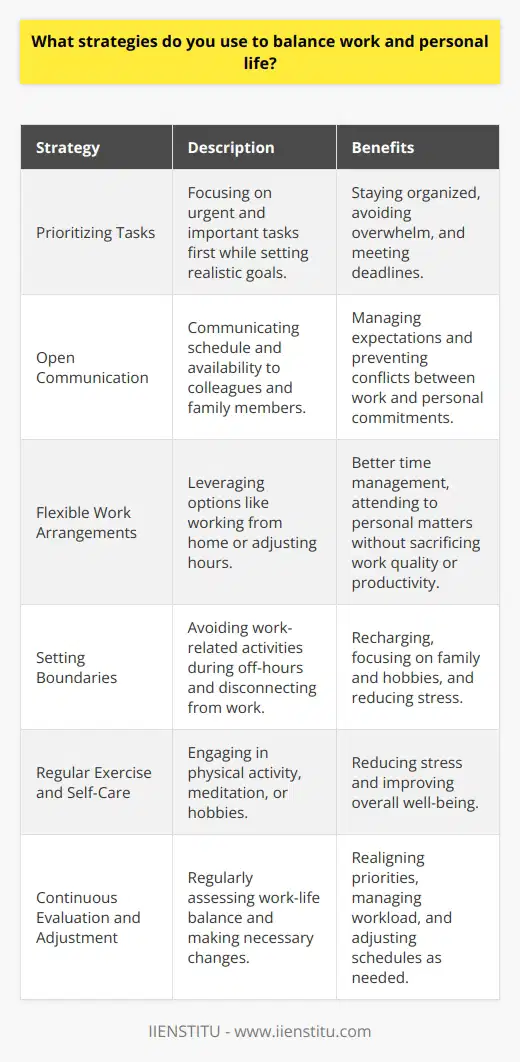
How do you handle unexpected interruptions to your schedule?
I handle unexpected interruptions to my schedule by remaining calm and adaptable. When an urgent matter arises that requires immediate attention, I take a moment to assess the situation and prioritize tasks based on their importance and urgency.
Communicate with the Team
If the interruption affects my team or project, I quickly communicate with relevant stakeholders. I update them on the situation and discuss how we can adjust our plans to accommodate the change.
Delegate Tasks When Necessary
If possible, I delegate some of my responsibilities to capable team members. This helps ensure that important work continues while I focus on resolving the unexpected issue.
Stay Focused and Efficient
Once I have a plan in place, I work diligently to address the interruption. I minimize distractions and stay focused on the task at hand, ensuring that I resolve the issue as efficiently as possible.
Learn from the Experience
After the interruption is resolved, I take time to reflect on the experience. I consider what I could have done differently and how I can better prepare for similar situations in the future. By learning from these experiences, I continually improve my ability to handle unexpected challenges.
In my previous role at XYZ Company, I once faced a major system outage just before an important client presentation. I quickly assessed the situation, communicated with my team, and we worked together to develop a contingency plan. By staying calm and focused, we were able to resolve the issue and deliver the presentation successfully. This experience taught me the importance of adaptability and teamwork in handling unexpected interruptions.

What tools or apps do you use to manage your time effectively?
I rely on a combination of digital tools and traditional methods to effectively manage my time. Google Calendar helps me keep track of important dates, meetings, and deadlines. I color-code entries to quickly identify priorities.
For day-to-day tasks, I prefer handwritten to-do lists. The act of physically writing out action items helps me remember and feel more committed to completing them. I keep one master list and then break it down into daily tasks. Crossing things off is so satisfying!
Prioritizing is Key
Regardless of the tools used, I've found that prioritizing is essential for good time management. I always tackle the most important, time-sensitive items first. This way, even if unexpected things come up, I still make meaningful progress. I've learned it's okay to say no sometimes too, to avoid overcommitting myself.
Designated Focus Time
To maximize productivity, I block off chunks of uninterrupted "focus time." During these sessions, I close my email, put my phone on silent, and concentrate fully on the task at hand. Even just 30-60 minutes of deep focus can yield impressive results.
Overall, using the right mix of tools, prioritizing well, and removing distractions have been key to managing my time effectively. It's an ongoing process, but I'm always looking for ways to work smarter. I'm confident these skills would serve me well in this role too.
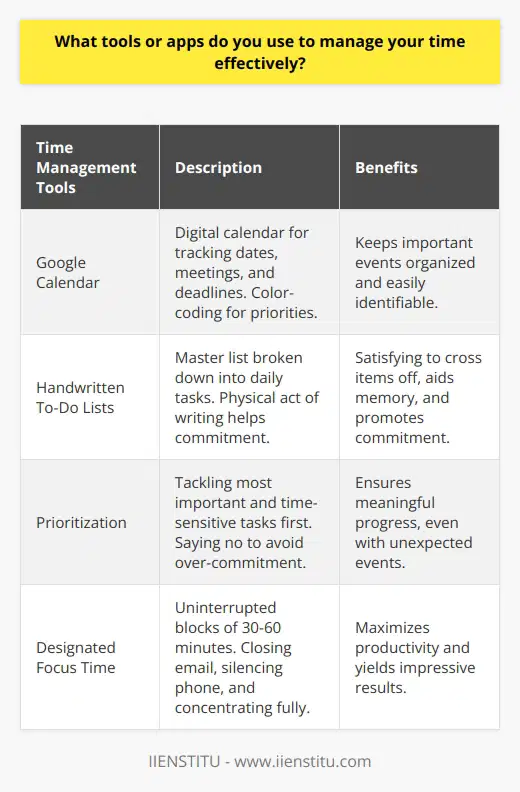
How do you ensure you meet deadlines while maintaining a healthy work-life balance?
Meeting deadlines while maintaining a healthy work-life balance is a challenge I've faced throughout my career. I've learned that the key is to prioritize tasks, communicate effectively, and set boundaries.
Prioritize and Plan
I start each week by reviewing my upcoming deadlines and prioritizing my tasks. I break larger projects into manageable chunks and set mini-deadlines to keep myself on track. This helps me avoid last-minute rushes and late nights at the office.
Communicate Proactively
Open communication with my team and manager is crucial. If I foresee any potential delays or roadblocks, I bring them up right away. We collaborate to find solutions or adjust timelines if needed. Being transparent manages expectations and prevents surprises.
Set Boundaries and Disconnect
I've learned to set clear boundaries between work and personal time. When I'm off the clock, I make an effort to truly disconnect. Spending quality time with loved ones and pursuing hobbies recharges me. It actually makes me more focused and productive when I am working.
Stay Organized and Flexible
Staying organized is key - I rely on to-do lists, calendars, and project management tools. But I also remain flexible, because unexpected tasks or changes are inevitable. Being adaptable helps me roll with the punches and still meet those deadlines.
At the end of the day, it's about finding the right balance for me. With good planning, communication, and boundaries, I'm able to consistently meet deadlines without sacrificing my well-being. It's an ongoing process, but I'm committed to making it work.

What techniques do you use to avoid procrastination?
As someone who values productivity and efficiency, I have developed several techniques to avoid procrastination and stay focused on my tasks.
Prioritizing and Breaking Down Tasks
I start by prioritizing my tasks based on their importance and urgency. This helps me tackle the most critical items first. I then break down larger tasks into smaller, manageable steps, making them less overwhelming and easier to accomplish.
Setting Realistic Goals and Deadlines
Setting realistic goals and deadlines for myself is crucial. I find that having a clear timeline keeps me motivated and accountable. I also make sure to celebrate small victories along the way, which boosts my morale and keeps me going.
Minimizing Distractions
To minimize distractions, I create a conducive work environment. I turn off notifications on my phone and computer, and I use website blockers to prevent myself from accessing time-wasting sites during work hours. If I find myself struggling to focus, I employ the Pomodoro Technique, working in focused 25-minute intervals with short breaks in between.
Embracing Accountability and Support
I find that having an accountability partner or joining a support group can be incredibly helpful in staying on track. Knowing that someone else is counting on me to follow through on my commitments is a powerful motivator. I also regularly share my goals and progress with my teammates, which keeps me accountable and fosters a sense of camaraderie.
Practicing Self-Care and Mindfulness
Finally, I prioritize self-care and mindfulness. I make sure to get enough sleep, eat well, and exercise regularly. When I feel overwhelmed or stressed, I take a few minutes to practice deep breathing or meditation. These practices help me maintain a positive outlook and keep procrastination at bay.
By employing these techniques consistently, I have been able to significantly reduce procrastination and increase my productivity both in my personal and professional life.

How do you allocate time for self-care and relaxation?
I believe that self-care and relaxation are essential for maintaining a healthy work-life balance. Taking time for yourself allows you to recharge, reduce stress, and improve your overall well-being.
Prioritizing "Me Time"
I make it a priority to set aside dedicated "me time" each day. Whether it's reading a book, practicing yoga, or taking a relaxing bath, I ensure that I have moments to unwind and focus on my own needs.
Scheduling Self-Care Activities
To ensure that self-care remains a priority, I schedule it into my calendar, just like any other important appointment. By treating it as a non-negotiable part of my routine, I'm more likely to follow through and make it a habit.
Engaging in Hobbies and Interests
I find that engaging in hobbies and interests outside of work is a great way to relax and recharge. For me, that means playing the guitar, hiking on weekends, and trying new recipes in the kitchen. These activities bring me joy and help me maintain a sense of balance.
Mindfulness and Meditation
Incorporating mindfulness and meditation into my daily routine has been a game-changer for managing stress and promoting relaxation. Even just a few minutes of deep breathing or guided meditation can help me feel more centered and focused throughout the day.
Overall, I believe that making self-care a priority is not only beneficial for my personal well-being but also for my professional performance. When I take care of myself, I'm better equipped to handle challenges, think creatively, and bring my best self to work each day.

What is your approach to planning your week ahead?
When it comes to planning my week ahead, I prefer to strike a balance between structure and flexibility. On Sunday evenings, I sit down with my planner and map out the key tasks and appointments for the upcoming week. This helps me visualize what needs to be accomplished and ensures that nothing falls through the cracks.
Prioritizing Tasks
I start by identifying the most critical and time-sensitive tasks, such as project deadlines or important meetings. These high-priority items get scheduled first, and I allocate sufficient time to complete them without rushing. I find that tackling the most challenging or daunting tasks early in the week, when my energy levels are high, sets a positive tone for the rest of the week.
Leaving Room for Flexibility
While having a structured plan is crucial, I also leave some wiggle room for unexpected tasks or opportunities that may arise. Life can be unpredictable, and I've learned that being too rigid with my schedule can lead to stress and frustration. By building in some buffer time and not overloading my calendar, I can adapt to changes without throwing my entire plan off course.
Regularly Reviewing and Adjusting
Throughout the week, I make it a habit to review my progress and adjust my plan as needed. I set aside a few minutes each morning to assess what I accomplished the previous day and tweak my schedule accordingly. This helps me stay on track and ensures that I'm making steady progress towards my goals.
Overall, my approach to planning my week is a combination of proactive organization and adaptability. By setting clear priorities, leaving room for flexibility, and regularly reviewing my progress, I'm able to navigate the challenges of the week with confidence and productivity.

How do you handle tasks that take longer than expected?
When faced with tasks that take longer than expected, I prioritize effective communication and proactive problem-solving. I believe in being transparent with my team and stakeholders about any challenges or delays that arise.
Assessing the Situation
First, I take a step back to evaluate the task at hand and identify the root causes of the delay. By analyzing the factors contributing to the extended timeline, I can develop a targeted action plan.
Breaking Down the Task
Next, I break down the task into smaller, manageable components. This allows me to tackle the work in phases and track progress more effectively. I set realistic milestones and deadlines for each phase to keep the project moving forward.
Collaborating with the Team
I actively collaborate with my team members to brainstorm solutions and leverage their expertise. By pooling our knowledge and resources, we can often find creative ways to overcome obstacles and expedite the process.
Keeping Stakeholders Informed
Throughout the project, I maintain open lines of communication with stakeholders. I provide regular updates on the task's status, any challenges encountered, and the revised timeline. This transparency helps manage expectations and fosters trust.
Learning and Adapting
Ultimately, I view tasks that take longer than expected as opportunities for growth and improvement. I reflect on the lessons learned and incorporate them into future projects. By continuously adapting my approach, I can become more efficient and better equipped to handle complex tasks.
In my previous role, I encountered a project that fell behind schedule due to unforeseen technical issues. By breaking down the task, collaborating with my team, and maintaining open communication with stakeholders, we successfully navigated the challenges and delivered a high-quality result. The experience taught me the importance of adaptability and proactive problem-solving in the face of unexpected delays.
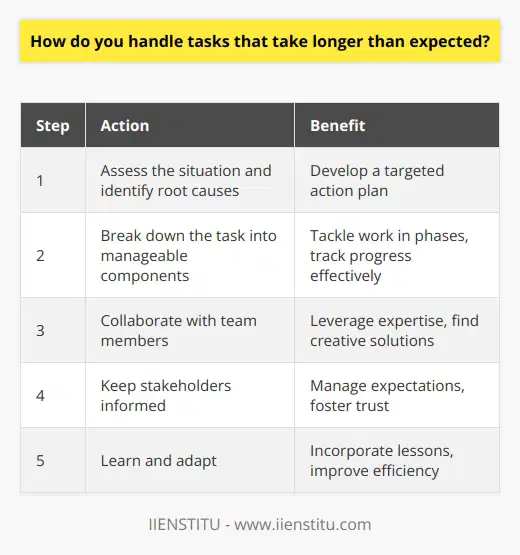
What methods do you use to stay focused and avoid distractions?
Staying focused and avoiding distractions is crucial for my productivity. Over the years, I've developed several effective strategies:
Prioritizing Tasks
Each morning, I make a to-do list and prioritize my tasks based on urgency and importance. This helps me stay organized and focused on what matters most.
Minimizing Distractions
I silence my phone notifications and close unnecessary browser tabs while working. If I'm struggling to concentrate, I'll put on noise-cancelling headphones and listen to instrumental music.
Taking Breaks
Paradoxically, taking regular short breaks actually helps me maintain focus. Every hour or so, I'll step away from my desk for 5-10 minutes to stretch, grab water, or do a quick meditation. This prevents burnout and keeps my mind fresh.
Using Time Blocks
I block off chunks of time on my calendar dedicated to specific tasks or projects. During these focused sessions, I give my full attention to the work at hand without multitasking or interruptions.
Leveraging Productivity Tools
Apps like Forest and RescueTime have been game-changers for keeping me on track. Forest encourages me to stay off my phone, while RescueTime automatically tracks how I spend my time and sends me detailed productivity reports.
With these methods, I'm able to dive deep into work, fight off distractions, and consistently produce high-quality results. It's an approach I've refined over time and one that I'm always looking to optimize further.
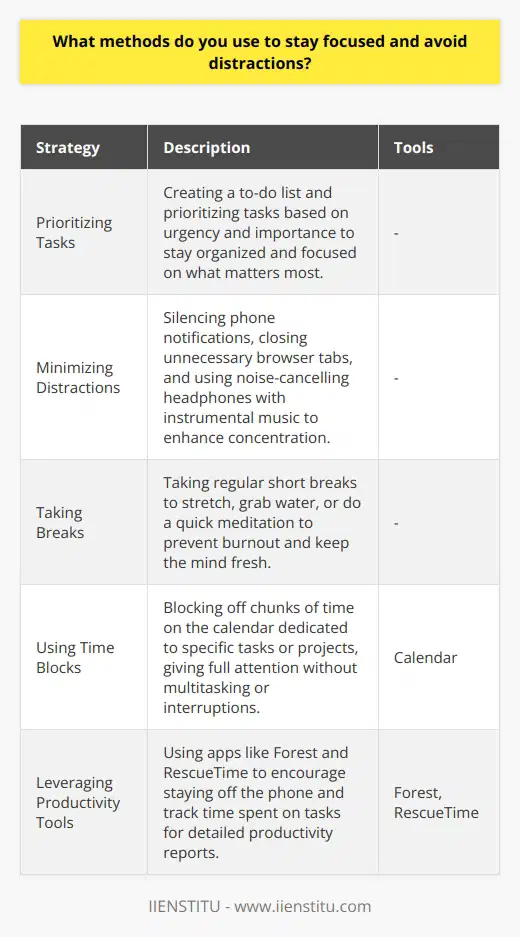
How do you prioritize tasks when everything seems equally important?
When faced with multiple tasks that seem equally important, I first take a step back and assess the bigger picture. I consider how each task aligns with the company's goals and priorities. This helps me identify which tasks have the greatest impact and urgency.
Communicating with Stakeholders
Next, I communicate with relevant stakeholders to gather their input and expectations. Their insights help me understand the relative importance and deadlines of each task. I believe in collaborating closely with colleagues to ensure everyone is on the same page.
Breaking Down Tasks
Once I have a clear understanding of the priorities, I break down larger tasks into smaller, manageable steps. This allows me to tackle them in a structured and efficient manner. I set realistic milestones and deadlines for each subtask to keep myself on track.
Staying Flexible and Adaptable
I also remain flexible and adaptable throughout the process. Priorities can shift unexpectedly, so I'm always ready to reassess and adjust my plan as needed. I stay calm under pressure and communicate any changes or challenges to my team promptly.
Leveraging Time Management Techniques
To maximize my productivity, I leverage various time management techniques like the Eisenhower Matrix and Pomodoro Technique. These tools help me focus on high-impact tasks while minimizing distractions. I also set aside dedicated time blocks for deep work and regular breaks to maintain my energy and concentration levels.
At the end of the day, prioritizing tasks when everything seems equally important is about striking a balance between strategic thinking, effective communication, and adaptability. By staying organized, collaborating with others, and remaining agile, I'm able to navigate competing priorities and deliver high-quality results consistently.
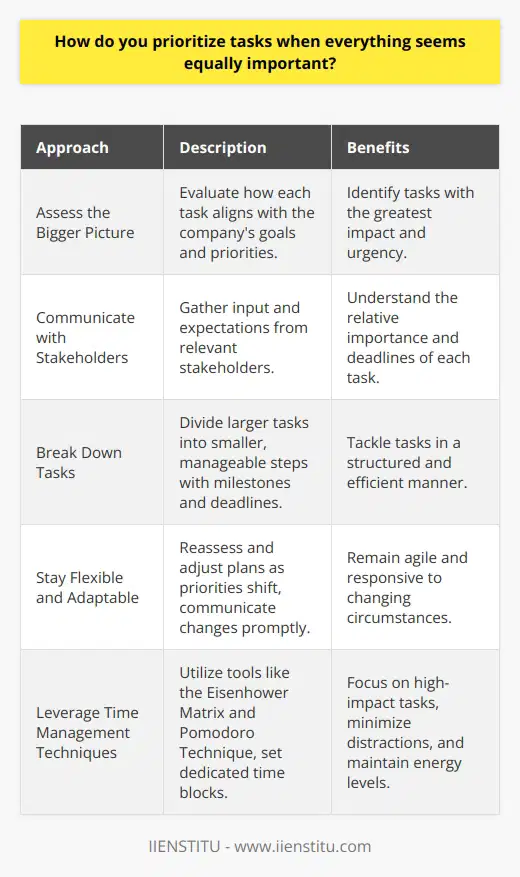
What do you do when you feel overwhelmed with your workload?
When I feel overwhelmed with my workload, I take a step back and prioritize my tasks. I create a to-do list and rank each item based on importance and urgency. This helps me focus on the most critical tasks first.
Communicate with Your Team
If the workload becomes unmanageable, I reach out to my team and supervisors. I believe in open communication and collaborating with colleagues to find solutions. Together, we can redistribute tasks or adjust deadlines to ensure a more balanced workload.
Take Breaks and Practice Self-Care
When stress levels rise, I make sure to take short breaks throughout the day. Whether it's a quick walk around the office or a few minutes of deep breathing exercises, these moments help me recharge and refocus. I also prioritize self-care outside of work, like getting enough sleep and exercise.
Continuously Improve Time Management Skills
I'm always looking for ways to enhance my time management skills. I attend workshops, read books, and experiment with different productivity techniques. By constantly learning and adapting, I can handle my workload more efficiently and effectively.
At the end of the day, feeling overwhelmed is a natural part of any job. What matters most is how we respond to those challenges. By staying organized, communicating with others, and taking care of ourselves, we can navigate even the busiest of times with grace and resilience.
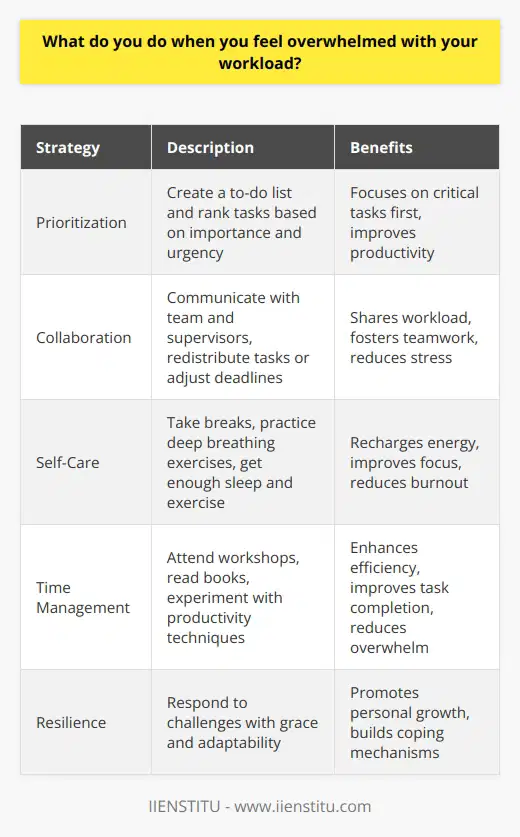
How do you handle situations where your personal and professional commitments clash?
When faced with situations where my personal and professional commitments clash, I strive to find a balance. Communication is key in these situations. I openly discuss any conflicts with my supervisor or team to find a solution.
Prioritizing and Planning
I prioritize my tasks based on urgency and importance. This helps me manage my time effectively. I also plan ahead to avoid last-minute conflicts between personal and work obligations.
Flexibility and Compromise
Being flexible is essential when juggling multiple commitments. I'm willing to adjust my schedule when necessary. Sometimes this means coming in early or staying late to complete a project. Other times, it involves delegating tasks or asking for help from colleagues.
Setting Boundaries
While I'm dedicated to my job, I also recognize the importance of personal time. I set clear boundaries between work and personal life. This allows me to fully engage in both areas without constant distractions or guilt.
Learning from Experience
Over time, I've gotten better at anticipating potential clashes. I've learned to be proactive in communicating and problem-solving. Each challenge has taught me valuable lessons about time management, communication, and adaptability.
Ultimately, finding harmony between personal and professional commitments is an ongoing process. It requires self-awareness, open communication, and a willingness to be flexible. By staying organized and communicating effectively, I'm able to honor both my work responsibilities and my personal life.
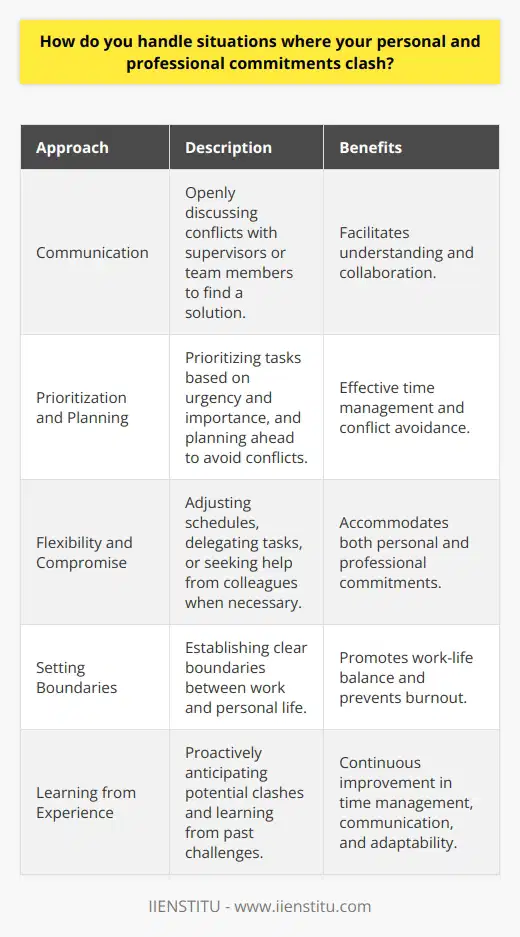
What strategies do you use to manage stress related to time constraints?
When faced with time constraints, I employ several strategies to manage stress effectively:
Prioritize tasks
I make a list of tasks and prioritize them based on urgency and importance. This helps me focus on what matters most and avoid getting overwhelmed by less critical tasks.
Break down projects
I break large projects into smaller, manageable steps. By tackling one piece at a time, I feel less stressed and more in control of my progress.
Set realistic deadlines
I set achievable deadlines for myself and communicate them clearly with my team. This way, everyone knows what to expect and can work together efficiently.
Practice mindfulness
When stress levels rise, I take a few minutes to practice deep breathing or meditation. These simple techniques help me stay calm, centered, and focused on the task at hand.
I remember a particularly challenging project where we had a tight deadline and limited resources. By applying these strategies, I was able to keep my cool and lead the team to a successful outcome. We delivered the project on time and received positive feedback from the client.
In my experience, managing stress is all about finding what works best for you. It takes practice and self-awareness, but with the right tools and mindset, it's possible to stay productive and maintain a healthy work-life balance, even under pressure.

How do you ensure you have enough time for family and friends?
Maintaining a healthy work-life balance is crucial to my overall well-being and productivity. I make a conscious effort to prioritize my personal relationships alongside my professional commitments.
Setting Boundaries
I establish clear boundaries between work and personal life. When I'm with family and friends, I focus on being present and engaged, leaving work-related matters aside.
Effective Time Management
I utilize time management techniques to ensure I make the most of my workday. By staying organized and efficient, I can complete my tasks within designated hours, leaving ample time for my loved ones.
Flexible Scheduling
I communicate openly with my employer about my need for a balanced lifestyle. I'm willing to be flexible when necessary, but I also advocate for reasonable working hours that allow me to nurture my personal relationships.
Quality Over Quantity
I believe in the importance of quality time spent with family and friends. Even if it's just a few hours a week, I make sure to create meaningful moments and cherished memories with them.
At the end of the day, I recognize that my personal life fuels my professional success. By ensuring I have sufficient time for my loved ones, I can approach my work with a refreshed mind and a positive outlook.
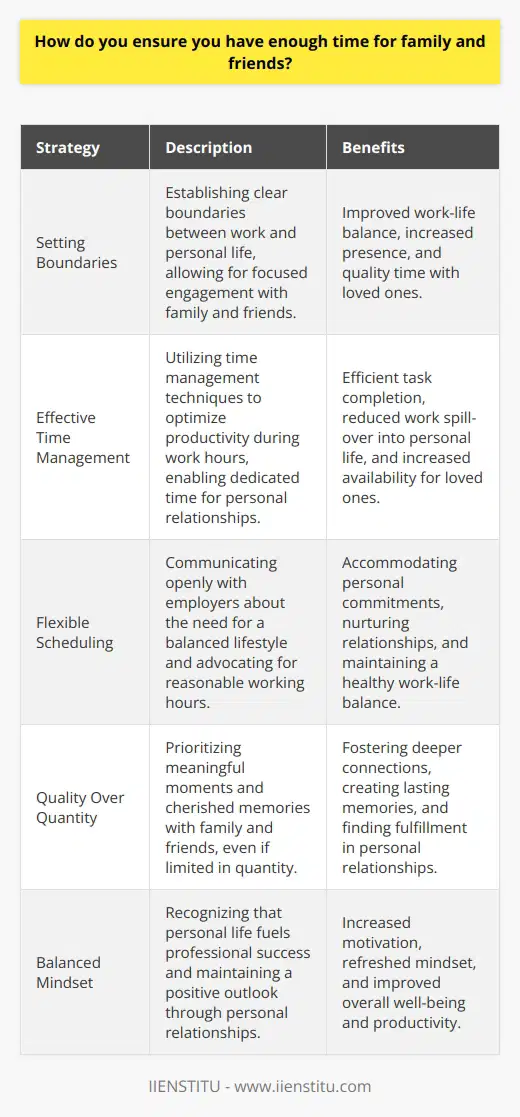
What techniques do you use to maximize your productivity during working hours?
To maximize my productivity during working hours, I employ several techniques that I've found effective over the years. Here are a few of the key strategies I use:
Prioritizing Tasks
I start each day by reviewing my to-do list and prioritizing tasks based on urgency and importance. This helps me focus on the most critical items first and ensures that I'm making the best use of my time.
Time Blocking
I divide my day into dedicated blocks of time for specific tasks or projects. During these focused periods, I minimize distractions and give my full attention to the task at hand. I find that this approach allows me to make significant progress and maintain a steady workflow.
Taking Regular Breaks
While it may seem counterintuitive, taking short breaks throughout the day actually boosts my productivity. I step away from my desk every hour or so to stretch, grab a quick snack, or simply rest my eyes. These brief moments of respite help me recharge and return to my work with renewed energy and focus.
Minimizing Distractions
I actively work to minimize distractions in my workspace. This includes silencing notifications on my phone and computer, closing unnecessary browser tabs, and using noise-canceling headphones when needed. By creating a distraction-free environment, I can fully immerse myself in my work and maintain a high level of concentration.
Leveraging Productivity Tools
I take advantage of various productivity tools to streamline my workflow and stay organized. For example, I use project management software to track tasks and deadlines, time tracking apps to monitor my progress, and collaboration platforms to communicate with my team. These tools help me stay on top of my responsibilities and work more efficiently.
By implementing these techniques consistently, I've found that I'm able to maximize my productivity during working hours and deliver high-quality results. Of course, it's an ongoing process, and I'm always looking for ways to fine-tune my approach and further improve my efficiency.
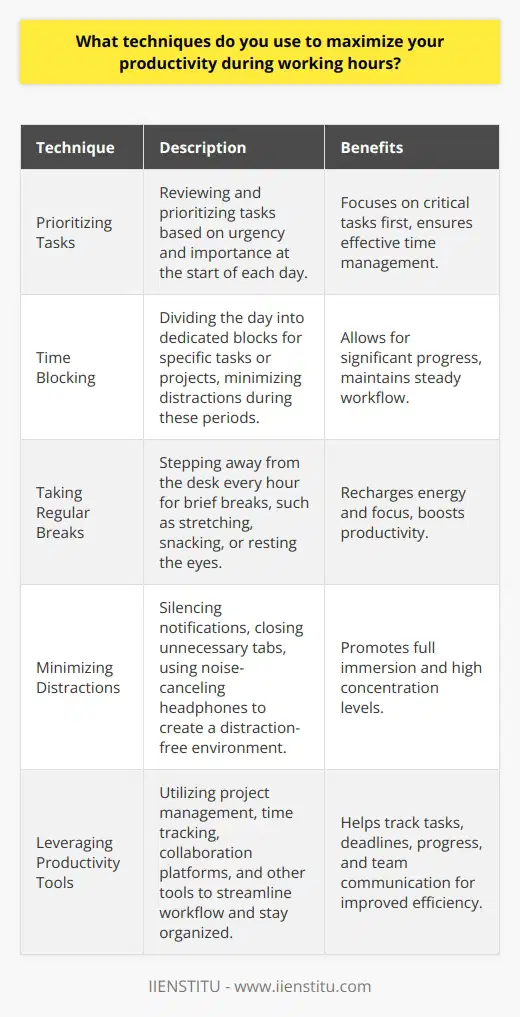
How do you balance short-term and long-term goals in your time management?
When it comes to balancing short-term and long-term goals in my time management, I believe in taking a strategic approach. I start by clearly defining my objectives and priorities, both for the immediate future and the bigger picture. This helps me create a roadmap for success.
Prioritizing Tasks
I prioritize my tasks based on urgency and importance. I tackle the most critical and time-sensitive items first, ensuring that I meet deadlines and deliver results. At the same time, I carve out dedicated time for long-term projects and goals, even if they don't have an immediate deadline.
Breaking Down Long-Term Goals
To make long-term goals more manageable, I break them down into smaller, actionable steps. This allows me to make consistent progress without feeling overwhelmed. I set milestones and regularly review my progress to stay on track.
Flexibility and Adaptability
I understand that priorities can shift, and unexpected challenges may arise. That's why I remain flexible and adaptable in my time management. If a short-term task requires immediate attention, I adjust my schedule accordingly while still keeping my long-term goals in mind.
Continuous Learning and Growth
I believe in continuous learning and growth. I dedicate time to expanding my skills and knowledge, as it contributes to both my short-term performance and long-term career development. I attend workshops, read industry publications, and seek mentorship opportunities to stay ahead of the curve.
Balancing short-term and long-term goals is an ongoing process that requires discipline, focus, and adaptability. By prioritizing tasks, breaking down long-term objectives, and remaining flexible, I am able to effectively manage my time and achieve both immediate results and long-term success in my career.
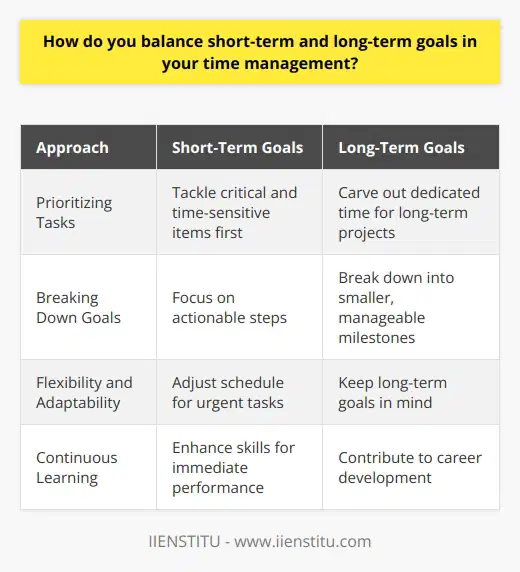
What is your approach to managing your energy levels throughout the day?
As someone who values productivity and well-being, I've developed a few strategies to manage my energy levels throughout the day:
Prioritizing Sleep
I make sure to get at least 7-8 hours of quality sleep each night. When I'm well-rested, I find that my energy is more stable and I'm better able to focus.
Starting the Day Right
In the mornings, I avoid rushing and take time for a nutritious breakfast. I also do some light stretching or a short walk to get my blood flowing and wake up both my body and mind.
Taking Regular Breaks
I've learned that powering through without breaks is counterproductive for me. Every 90 minutes or so, I step away from my work to stretch, get some fresh air, or chat with a coworker. These short breaks help me recharge and return to my tasks with renewed focus.
Staying Hydrated and Fueled
I keep a water bottle at my desk and sip regularly to stay hydrated. I also have healthy snacks like fruit, nuts, or yogurt to maintain my energy levels without crashes from sugary or greasy foods.
Prioritizing Important Tasks
I tackle my most challenging or important work when my energy is highest, usually in the morning. I save easier tasks for times when I know my focus may dip, like right after lunch.
By being proactive and listening to my body's needs, I'm able to keep my energy and productivity high while still maintaining balance. It's an approach that has served me well in both my personal and professional life.
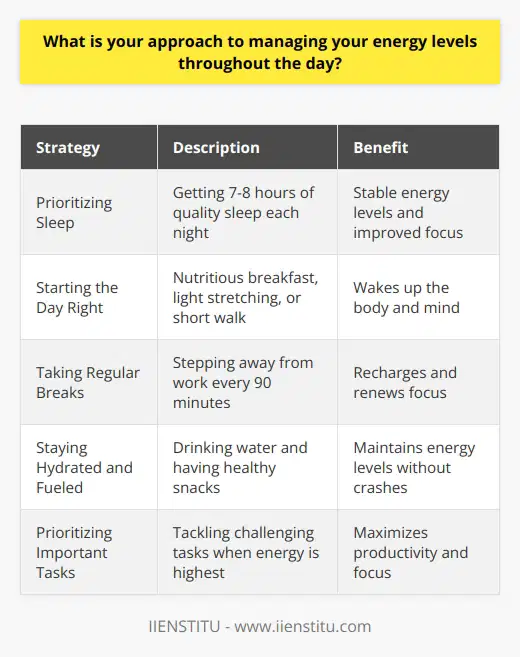
How do you handle tasks that you find tedious or unpleasant?
When faced with tedious or unpleasant tasks, I try to approach them with a positive mindset. I remind myself that every job has its challenges and that completing these tasks is part of being a responsible employee.
Breaking Down the Task
One strategy I use is breaking down the task into smaller, more manageable steps. This helps me focus on one thing at a time and not feel overwhelmed by the entire project. I set mini-goals for myself and celebrate each milestone along the way.
Finding Ways to Make It Enjoyable
Another approach I take is trying to find ways to make the task more enjoyable. For example, if I'm working on a repetitive data entry project, I might listen to my favorite podcast or music to keep myself entertained. I also try to vary my work environment when possible, like working in a different room or taking short breaks to refresh my mind.
Collaborating with Colleagues
If the task allows, I reach out to colleagues for help or advice. Collaborating with others can make the work feel less tedious and more engaging. I'm always willing to lend a hand to my coworkers as well, knowing that we're all in this together.
Focusing on the Big Picture
Ultimately, I try to keep the big picture in mind. I remember that even the most unpleasant tasks contribute to the company's overall success. Knowing that my work matters helps me stay motivated and push through any challenges that come my way.

What strategies do you use to avoid burnout?
I use several strategies to avoid burnout and maintain a healthy work-life balance. First and foremost, I prioritize self-care. This includes getting enough sleep, eating well, and exercising regularly.
Setting Boundaries
I set clear boundaries between work and personal life. When I'm off the clock, I disconnect from work-related tasks and focus on relaxing and recharging. I avoid checking emails or taking work calls during my free time.
Time Management
Effective time management is key to preventing burnout. I break down large projects into smaller, manageable tasks and tackle them one at a time. This helps me avoid feeling overwhelmed and allows me to make steady progress.
Delegating and Asking for Help
I'm not afraid to delegate tasks when necessary and ask for help when I need it. Collaborating with colleagues and sharing the workload can alleviate stress and prevent burnout.
Hobbies and Interests Outside of Work
Engaging in hobbies and interests outside of work is crucial for maintaining a balanced life. I enjoy hiking on weekends and attending yoga classes twice a week. These activities help me relax, de-stress, and recharge.
By implementing these strategies, I've been able to avoid burnout and maintain a healthy work-life balance. It's an ongoing process that requires self-awareness and adaptability, but it's essential for long-term success and well-being.
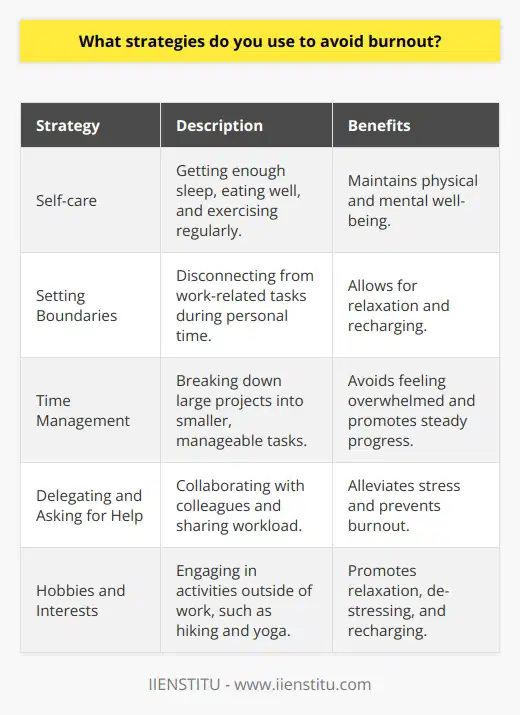
How do you adapt your time management techniques to different projects or roles?
When it comes to adapting my time management techniques to different projects or roles, I always start by assessing the unique requirements and goals of each situation. This helps me determine what approach will be most effective.
Prioritizing Tasks
I prioritize tasks based on their urgency and importance, ensuring that I tackle the most critical items first. By focusing on high-impact activities, I can make significant progress towards achieving the project's objectives.
Flexibility and Adaptability
I understand that different projects and roles may require different time management strategies. For example, when I was working on a tight deadline for a client presentation, I broke down the project into smaller, manageable tasks and set strict timelines for each one. This allowed me to stay on track and deliver the presentation successfully.
On the other hand, when I was leading a long-term research project, I adopted a more flexible approach. I set regular check-ins with my team to monitor progress and adjust our plans as needed, ensuring that we could adapt to any changes or challenges that arose along the way.
Communication and Collaboration
Effective time management often involves clear communication and collaboration with others. I make sure to keep my team members informed about my progress and any potential roadblocks, and I'm always open to their input and feedback. By fostering a culture of open communication, we can work together to find solutions and keep projects moving forward.
Ultimately, I believe that the key to adapting time management techniques is to remain agile and open-minded. By staying focused on the end goal, while also being willing to adjust my approach as needed, I can consistently deliver results and exceed expectations, no matter what project or role I'm taking on.
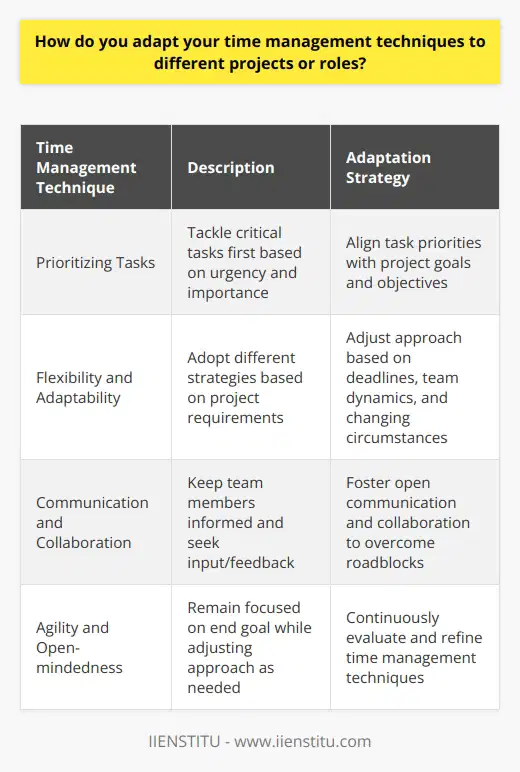
What do you do when you realize you've overcommitted yourself?
When I realize I've overcommitted myself, the first thing I do is take a step back and reassess my priorities. It's important to be honest with myself about what I can realistically accomplish within the given timeframe.
Communicate with Stakeholders
Next, I communicate with the relevant stakeholders, whether it's my boss, colleagues, or clients. I explain the situation transparently and propose alternative solutions or timelines. Being proactive in communication helps manage expectations and find mutually agreeable resolutions.
Prioritize and Delegate
To tackle an overcommitted schedule, I prioritize tasks based on urgency and importance. I focus on the most critical items first. If possible, I delegate some responsibilities to teammates or subordinates who have the skills and capacity to handle them.
Renegotiate Deadlines
In some cases, it may be necessary to renegotiate deadlines. I approach this conversation with a plan in mind, outlining what I can deliver and by when. Most people appreciate honesty and are willing to find a compromise.
Learn from the Experience
Finally, I treat overcommitment as a learning opportunity. I reflect on how I got into this situation and what I can do differently next time. This helps me improve my time management and estimation skills for future projects.
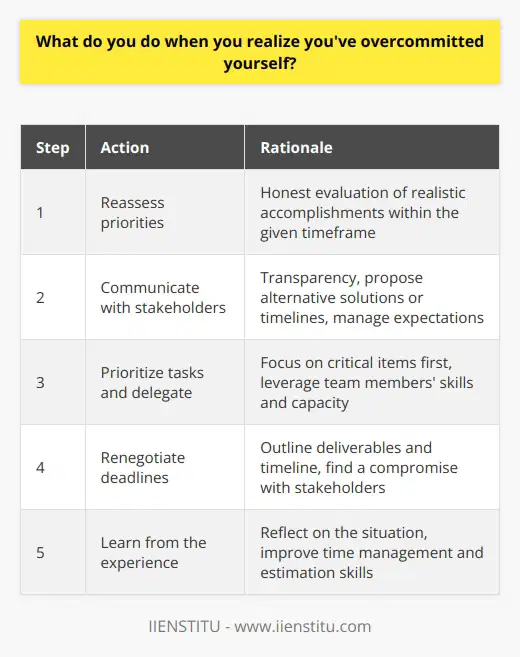
How do you prioritize self-development and learning in your schedule?
I believe that continuous learning and self-development are essential for personal and professional growth. In my schedule, I prioritize these activities by setting aside dedicated time each week to focus on acquiring new skills and knowledge.
Making Time for Learning
I block out specific hours in my calendar for learning activities, treating them as important appointments. This ensures that I consistently invest in my own development, even when faced with competing priorities.
Choosing Relevant Resources
To make the most of my learning time, I carefully select resources that align with my career goals. I enjoy reading industry blogs, attending webinars, and participating in online courses to stay up-to-date with the latest trends and best practices in my field.
Applying New Knowledge
I believe that true learning happens when you put new knowledge into practice. After acquiring new skills, I actively seek opportunities to apply them in my work. This helps me reinforce my understanding and demonstrate my commitment to continuous improvement.
Learning from Others
In addition to self-study, I value the insights and experiences of my colleagues and mentors. I make an effort to engage in meaningful conversations, seek feedback, and learn from their successes and challenges. This collaborative approach to learning has been instrumental in my personal and professional growth.
By prioritizing self-development and learning, I have been able to expand my skill set, take on new responsibilities, and contribute more effectively to my team's success. I believe that this commitment to continuous improvement will serve me well throughout my career, and I look forward to further opportunities to learn and grow in this role.
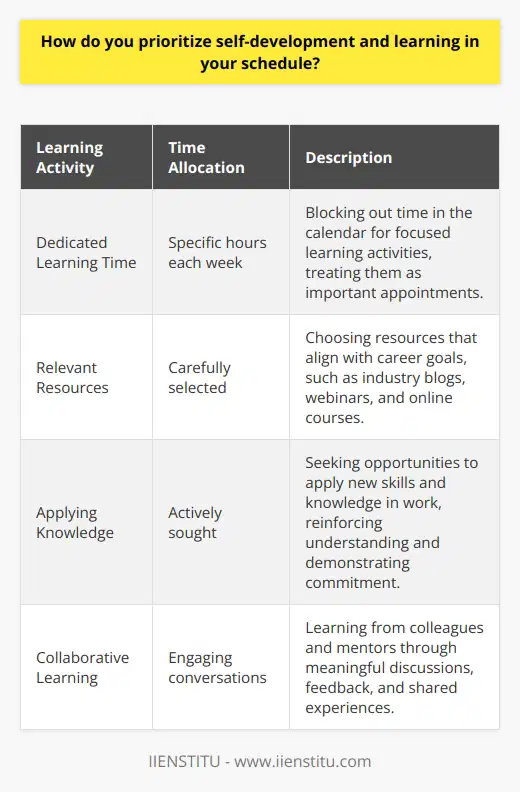
What techniques do you use to stay organized and on top of your tasks?
I rely on a combination of digital tools and analog methods to stay organized and productive. My go-to app is Todoist, which allows me to create tasks, set deadlines, and categorize them into projects. I love how it syncs seamlessly across my devices, so I can access my to-do list anytime, anywhere.
Prioritizing Tasks
In addition to digital tools, I'm a big believer in the power of prioritization. Every morning, I review my task list and identify the top three items that are most critical for the day. This helps me focus on what truly matters and avoid getting sidetracked by less important tasks.
Breaking Down Projects
When facing large projects, I break them down into smaller, manageable chunks. I find that this approach makes the work feel less overwhelming and allows me to make steady progress. I use a physical notebook to map out the steps involved and track my progress along the way.
Regular Check-ins
Throughout the day, I have regular check-in points where I assess my progress and adjust my plans if needed. This helps me stay accountable and ensures that I'm always moving forward.
Embracing Flexibility
While having a solid organizational system is crucial, I also believe in staying flexible. Things can change quickly in the workplace, so I'm always ready to adapt my plans and reprioritize as needed. By staying agile, I can respond effectively to new challenges and opportunities.
At the end of the day, staying organized is all about finding the tools and techniques that work best for you. Through trial and error, I've developed a system that keeps me on track and allows me to consistently deliver high-quality work.
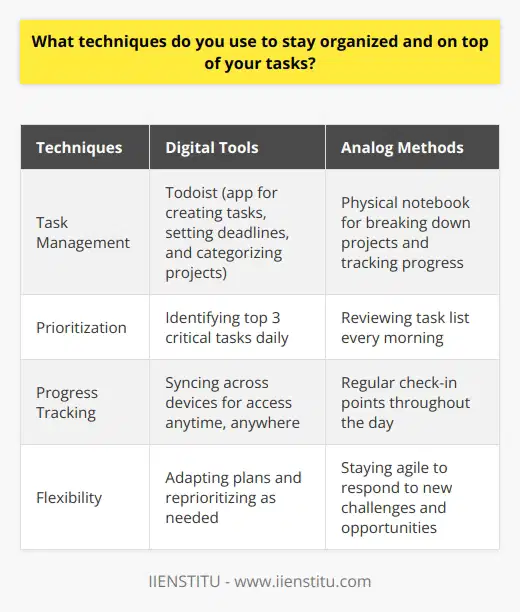
How do you handle interruptions from colleagues or family members?
I handle interruptions from colleagues or family members by setting clear boundaries and communicating my needs. I believe in open and honest dialogue to ensure everyone understands when I need uninterrupted focus time.
Prioritizing Tasks
When an interruption arises, I quickly assess the urgency and importance of the request. If it's critical, I address it promptly. If not, I politely explain that I'll follow up as soon as possible.
Minimizing Distractions
To minimize interruptions, I proactively inform others when I need to concentrate on a task. I close my office door or put on headphones to signal that I'm in focus mode.
Scheduling Time for Interruptions
I also block off specific times in my calendar for answering questions and addressing concerns. This allows me to handle interruptions in a structured manner without derailing my entire day.
Encouraging Self-Sufficiency
Over time, I've learned to empower my colleagues and family to be more self-sufficient. I provide them with the resources and information they need to handle certain situations independently.
Remaining Flexible
Despite my best efforts, unexpected interruptions sometimes occur. When they do, I remain calm and adaptable. I reassess my priorities and adjust my schedule as needed to ensure I still meet my commitments.
By using these strategies, I'm able to effectively manage interruptions while maintaining strong relationships and delivering high-quality work.
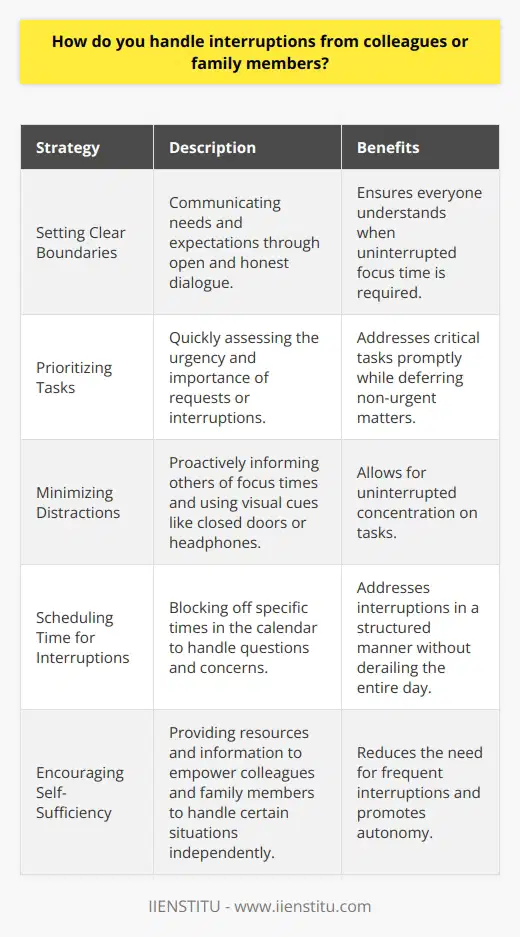
What is your approach to managing your email and other communications?
When it comes to managing my email and other communications, I have developed a systematic approach over the years. This approach helps me stay organized, responsive, and efficient in my professional interactions.
Prioritizing and Categorizing
I start by prioritizing my inbox based on urgency and importance. I use labels and folders to categorize messages, making it easier to find and respond to them later. This system allows me to focus on the most critical communications first.
Setting Aside Dedicated Time
I set aside specific times during the day to check and respond to emails. This helps me avoid constant distractions and maintain a healthy work-life balance. Of course, if there's an urgent matter, I address it promptly.
Being Clear and Concise
When crafting emails or other messages, I strive for clarity and conciseness. I aim to convey my thoughts and ideas in a way that is easy to understand, avoiding unnecessary jargon or wordiness. This approach ensures effective communication and saves time for everyone involved.
Following Up and Keeping Records
I believe in the importance of follow-up and keeping records. If I'm awaiting a response or need to take action on a communication, I set reminders for myself. I also keep a record of important conversations and decisions for future reference.
Overall, my approach to managing communications is based on organization, efficiency, and clear communication. I find that this system helps me collaborate effectively with colleagues, clients, and stakeholders, ensuring that nothing falls through the cracks.
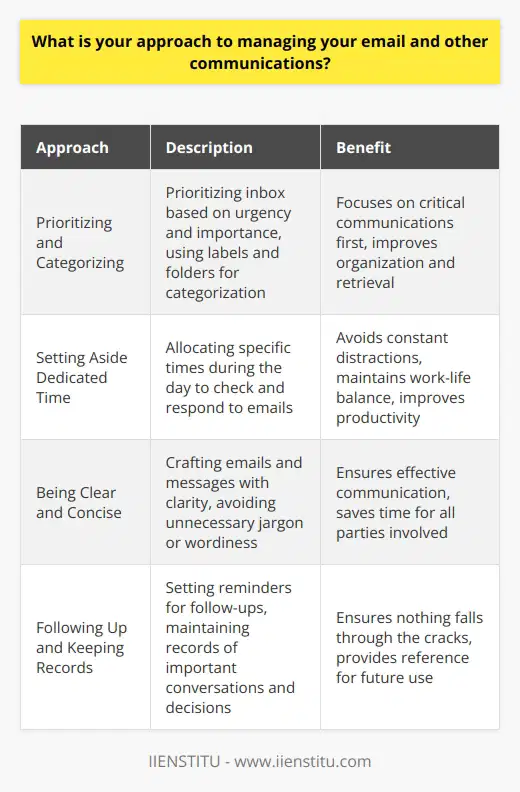
How do you ensure you have time for hobbies and personal interests?
I ensure I have time for hobbies and personal interests by prioritizing my tasks and managing my time effectively. At the beginning of each week, I review my schedule and allocate specific time slots for my hobbies. This helps me maintain a healthy work-life balance and reduces stress levels.
Scheduling Hobbies
I treat my hobbies as important appointments and schedule them in my calendar, just like work meetings. By doing this, I make sure I don't overlook them and give them the attention they deserve. I also communicate my hobby schedule to my family and friends, so they understand when I'm unavailable.
Flexible Working Hours
I'm fortunate to have a job that offers flexible working hours. This allows me to structure my day in a way that accommodates both my work responsibilities and personal interests. For example, if I have a hobby class in the evening, I might start work earlier that day to ensure I finish on time.
Maximizing Weekends and Holidays
I make the most of my weekends and holidays by dedicating significant time to my hobbies. Whether it's a weekend hike with friends or a week-long painting retreat, I plan ahead and use these breaks to fully immerse myself in my passions. It's a great way to recharge and return to work with renewed energy and creativity.
Hobbies as a Priority
I believe that hobbies are essential for personal growth and happiness. They provide a sense of fulfillment and help me develop skills outside of my professional life. By making them a priority, I ensure that I have a well-rounded and satisfying life, which ultimately benefits my work performance as well.

What strategies do you use to maintain a consistent sleep schedule?
Maintaining a consistent sleep schedule is crucial for my overall well-being and productivity. I've developed several strategies over the years that help me stick to a regular sleep routine.
Setting a Fixed Wake-Up Time
I've found that waking up at the same time every day, even on weekends, helps regulate my body's internal clock. By doing this, I naturally start feeling sleepy around the same time each night, making it easier to fall asleep.
Creating a Relaxing Bedtime Routine
About an hour before bed, I start winding down by turning off electronic devices and engaging in calming activities like reading a book or taking a warm bath. This helps signal to my brain that it's time to sleep.
Keeping the Bedroom Environment Conducive to Sleep
I make sure my bedroom is dark, quiet, and cool. I invested in comfortable bedding and pillows that support my body. Creating a peaceful sleep environment has made a big difference in the quality of my rest.
Limiting Caffeine and Heavy Meals Late in the Day
I avoid consuming caffeine after 3 pm and try not to eat large meals close to bedtime. This prevents digestive discomfort and helps me fall asleep more easily.
By implementing these strategies consistently, I've been able to maintain a regular sleep schedule that keeps me energized and focused throughout the day. It's not always perfect, but I've found that these habits make a significant difference in the long run.

How do you handle jet lag or adjusting to different time zones?
When it comes to handling jet lag or adjusting to different time zones, I have a few tried-and-true strategies that work for me.
Gradual Adjustment
I start adjusting my sleep schedule a few days before traveling. I gradually shift my bedtime and wake-up time closer to the destination time zone. This helps my body adapt more smoothly to the new schedule.
Light Exposure
Upon arrival, I try to get outside and soak up some natural light. Sunlight helps regulate my circadian rhythm and makes me feel more energized. If it's daytime when I arrive, I resist the urge to nap and push through until the evening.
Staying Hydrated
Dehydration can worsen jet lag symptoms, so I make sure to drink plenty of water before, during, and after the flight. I avoid alcohol and excessive caffeine, which can disrupt sleep patterns.
Maintaining a Routine
Even in a new time zone, I try to stick to my usual routine as much as possible. I eat meals at regular times, exercise, and wind down before bed with a relaxing activity like reading or listening to music.
Embracing the Local Schedule
Once I reach my destination, I fully embrace the local schedule. I eat meals at the typical times for that location and try to stay active during the day. If I'm struggling to fall asleep at night, I might take a short nap in the early afternoon, but I keep it under 30 minutes to avoid interfering with my nighttime sleep.
With these strategies, I find that I can usually overcome jet lag within a day or two and feel fully adjusted to the new time zone. It's all about listening to my body, being proactive, and giving myself some grace as I adapt.

What techniques do you use to make the most of your commute time?
I make the most of my commute time by staying productive and focused. Here are some techniques I use:
Plan ahead
Before leaving for work, I organize my thoughts and prioritize my tasks for the day. This mental preparation helps me hit the ground running when I arrive at the office.
Listen to podcasts or audiobooks
I'm a big fan of educational content, so I often queue up informative podcasts or audiobooks for my commute. Just last week, I finished an enthralling book about the history of cryptocurrency while stuck in traffic!
Review notes or brainstorm ideas
If I'm preparing for a big meeting or presentation, I'll use my travel time to review my notes and talking points. I might jot down some last-minute ideas that come to me.
Respond to emails
When taking public transportation, I triage my inbox and draft responses to simpler emails. Of course, I'm always careful not to get too absorbed in my phone if I'm walking or need to stay alert!
Practice mindfulness
On days when I'm feeling stressed or overwhelmed, I'll use my commute for a quick mindfulness session. Even just a few minutes of deep breathing and mentally releasing tension does wonders for my focus and mood.
The key is to be intentional with my time and not let those valuable minutes go to waste. By adopting these habits, I arrive at work energized and ready to tackle the day ahead.



